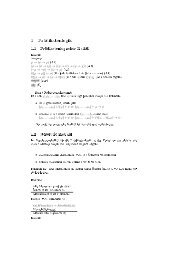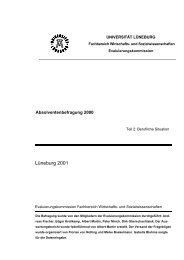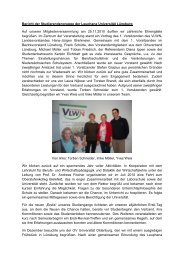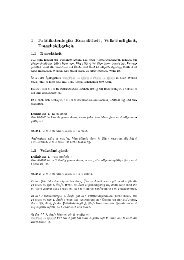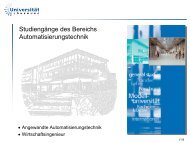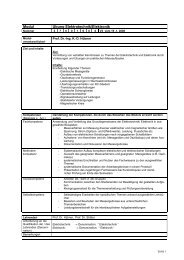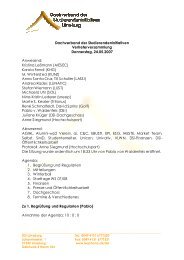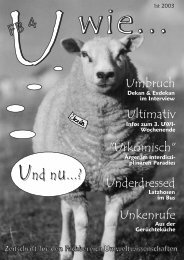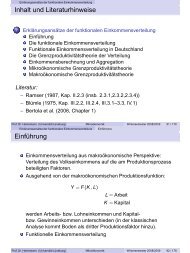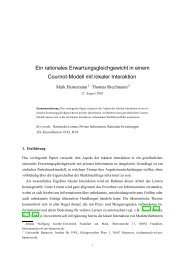Diversity as a potential for surprise
Diversity as a potential for surprise
Diversity as a potential for surprise
You also want an ePaper? Increase the reach of your titles
YUMPU automatically turns print PDFs into web optimized ePapers that Google loves.
<strong>Diversity</strong> <strong>as</strong> a <strong>potential</strong> <strong>for</strong> <strong>surprise</strong><br />
An in<strong>for</strong>mation theoretic me<strong>as</strong>ure<br />
of effective product diversity<br />
Stefan Baumgärtner 1<br />
Interdisciplinary Institute <strong>for</strong> Environmental Economics,<br />
University of Heidelberg, Germany<br />
7 May 2004 (Version 4.2)<br />
Abstract: In the face of uncertainty, diversity causes <strong>surprise</strong>. Taking the view of<br />
a consumer with incomplete knowledge of the choice set, I propose to take the expected<br />
<strong>surprise</strong> when sequentially observing an allocation <strong>as</strong> a me<strong>as</strong>ure of effective<br />
diversity of that allocation. Expected <strong>surprise</strong> can be quantified <strong>as</strong> the expected<br />
in<strong>for</strong>mation content of an observation (entropy). In this approach, effective product<br />
diversity is determined by (i) the pure number of different products and (ii)<br />
the evenness of distribution of their market shares. The concept is illustrated by<br />
an empirical analysis of the allocation of p<strong>as</strong>senger cars in Germany.<br />
JEL-cl<strong>as</strong>sification: D11, L11, L62<br />
Key words: auto industry, entropy, diversity, in<strong>for</strong>mation, market concentration,<br />
product variety, <strong>surprise</strong>, uncertainty<br />
Correspondence:<br />
Dr. Stefan Baumgärtner, Interdisciplinary Institute <strong>for</strong> Environmental Economics,<br />
University of Heidelberg, Bergheimer Str. 20, D-69115 Heidelberg, Germany,<br />
phone: +49.6221.54-8012, fax: +49.6221.54-8020, email: baumgaertner@uni-hd.de,<br />
http://www.stefan-baumgaertner.de<br />
1 I am grateful to Switgard Feuerstein, Ralph Winkler and seminar participants in Heidelberg<br />
and Stockholm (EEA2003) <strong>for</strong> critical discussion and helpful comments on earlier drafts; to Eva<br />
Kiesele <strong>for</strong> research <strong>as</strong>sistance with the data evaluation used in Section 4; to the Energy and<br />
Resources Group at the University of Cali<strong>for</strong>nia/Berkeley, where the first draft of this manuscript<br />
w<strong>as</strong> written, <strong>for</strong> their hospitality in 2001/2002; to the Deutsche Forschungsgemeinschaft (DFG)<br />
<strong>for</strong> financial support; and – l<strong>as</strong>t, not le<strong>as</strong>t – to Clemens Puppe <strong>for</strong> most stimulating discussions<br />
on diversity.
1 Introduction<br />
In the face of uncertainty, diversity causes <strong>surprise</strong>. As an illustration by contr<strong>as</strong>t,<br />
imagine an economy where there exists only one make of car, now and <strong>for</strong>ever. (As<br />
a matter of history, the <strong>for</strong>merly socialist economies of central and e<strong>as</strong>tern Europe<br />
were pretty close to this extreme.) Living in such an economy, you would exactly<br />
know which car you would be driving <strong>for</strong> the rest of your life. You would exactly<br />
know which car your kids would get one day. If you were to win the main prize in<br />
the lottery – a brand new car – you would exactly know what car that would be.<br />
And if you were to die in a traffic accident, guess what car would have caused it.<br />
Without diversity, you really cannot expect much <strong>surprise</strong>.<br />
While the view of diversity <strong>as</strong> a <strong>potential</strong> <strong>for</strong> <strong>surprise</strong> may seem elusive, a<br />
number of more direct economic re<strong>as</strong>ons have been proposed why diversity matters:<br />
• <strong>Diversity</strong> of a portfolio of options provides insurance <strong>for</strong> risk averse agents,<br />
e.g. when investing in financial <strong>as</strong>sets (Eichberger and Harper 1997) or when<br />
devising corporate strategies (Berry 1975, Jacquemin and Berry 1979).<br />
• <strong>Diversity</strong> of current technology and knowledge is a <strong>potential</strong> resource b<strong>as</strong>e<br />
<strong>for</strong> future invention and innovation (Mowery and Rosenberg 1998, Schiller<br />
2001).<br />
• <strong>Diversity</strong> allows a competitive economy to efficiently adapt to un<strong>for</strong>eseen contingencies,<br />
such <strong>as</strong> evolutionary changes in preferences, technology, resource<br />
scarcity and institutions (Dekel et al. 1998, Matutinović 2001).<br />
• <strong>Diversity</strong> is tantamount <strong>for</strong> the freedom of choice of autonomous persons<br />
(Puppe 1996, Sen 1988, Weikard 1999).<br />
All of these arguments share the view that the economic relevance of diversity is<br />
intimately related to uncertainty or even fundamental ignorance about the future.<br />
And <strong>surprise</strong> is just one expression of such uncertainty (Shackle 1955, Faber et al.<br />
1992).<br />
The simplest me<strong>as</strong>ure of diversity – and <strong>for</strong> that sake let’s return to product diversity<br />
– is the number of different products available in an economy. This me<strong>as</strong>ure<br />
is used in the strand of literature on product differentiation under monopolistic<br />
competition and incre<strong>as</strong>ing returns to scale, which goes back to the seminal contributions<br />
of Spence (1976) and Dixit and Stiglitz (1977). It underlies the influential<br />
works on economic growth through product or factor differentiation (Ethier 1982,<br />
Romer 1987, 1990) and on gains from international trade in differentiated products<br />
(Dixit and Norman 1980, Ethier 1982, Helpman and Krugman 1985).<br />
The pure number of different products, however, does not tell anything about<br />
how different they are. In a more fundamental sense, diversity stems from the<br />
dissimilarity between different products in terms of some characteristic properties<br />
or attributes (Lanc<strong>as</strong>ter 1966). The diversity of a set of products may be defined <strong>as</strong><br />
an aggregate me<strong>as</strong>ure of their dissimilarity. Recently, Weitzman (1992, 1998), Gans<br />
2
and Hill (1997), Bernhofen (2001) and Nehring and Puppe (2002) have suggested<br />
various approaches <strong>for</strong> me<strong>as</strong>uring (product) diversity in such a way.<br />
All of these approaches are static and furthermore <strong>as</strong>sume complete knowledge<br />
about the number and properties of the different products available. Yet, the<br />
relevance of diversity stems exactly from not knowing all the available products<br />
and all their attributes. Such incomplete knowledge, I shall argue, should be<br />
constituent <strong>for</strong> the definition and me<strong>as</strong>urement of diversity. I want to suggest<br />
that product diversity can be defined and me<strong>as</strong>ured <strong>as</strong> the expected <strong>surprise</strong> that<br />
an unin<strong>for</strong>med person encounters when sequentially observing which products are<br />
present in the actual allocation of an economy. For simplification, I adopt the<br />
<strong>as</strong>sumption that all the different products are pairwise equally dissimilar. Thus,<br />
diversity becomes a matter merely of the number of different products.<br />
A distinction can then be made between pure product diversity and effective<br />
product diversity. Pure product diversity denotes the number of different products<br />
existent in an economy and is a technological, or objective, me<strong>as</strong>ure of diversity.<br />
Effective product diversity, on the other hand, adopts the consumers’ point of view<br />
and captures an unin<strong>for</strong>med economic agents’ perception of a diverse allocation.<br />
It, thus, is a subjective me<strong>as</strong>ure of product diversity.<br />
Consider, <strong>for</strong> example, an allocation with five different car models. Assume<br />
they have market shares of 50%, 40%, 6%, 3% and 1%. What effective diversity<br />
would you attribute to that allocation? In other words, if you were out there<br />
in the street and would watch the cars come by, one by one, how much <strong>surprise</strong><br />
can you expect? The pure product diversity which, in principle, exists in the<br />
allocation is five different car models. Effectively, however, you should not expect<br />
the same degree of <strong>surprise</strong>, or effective diversity, <strong>as</strong> if there were five different and<br />
equally abundant car models. The two with the highest market share dominate the<br />
allocation, and they also dominate your impression of diversity in that allocation.<br />
Effectively, your perceived diversity will be little more than two car models, <strong>as</strong><br />
you may probably not even see one of the car models with negligible market share<br />
when observing the actual aggregate allocation.<br />
In order to quantify the expected <strong>surprise</strong> of unin<strong>for</strong>med consumers when observing<br />
an allocation, I will employ concepts from in<strong>for</strong>mation theory, in particular<br />
the concepts of an ‘in<strong>for</strong>mation function’ and ‘entropy’ (Shannon 1948, Rényi<br />
1961), to derive a general me<strong>as</strong>ure of effective product diversity (Section 2). It<br />
will turn out that this me<strong>as</strong>ure of effective product diversity is intimately linked<br />
to common me<strong>as</strong>ures of market concentration (Section 3). It is identical to the<br />
cl<strong>as</strong>s of me<strong>as</strong>ures of market concentration suggested by Hannah and Kay (1977),<br />
and is a subcl<strong>as</strong>s of the general and unifying cl<strong>as</strong>s of concentration indices that<br />
h<strong>as</strong> been described in an axiomatic way by Foster and Shneyerov (1999). Thus,<br />
the interesting relation between effective product diversity and market concentration<br />
may also shed new light on the interpretation of different me<strong>as</strong>ures of market<br />
concentration, which have been criticized in the p<strong>as</strong>t <strong>for</strong> their apparent ‘lack of<br />
content’ (Shepherd 1987b: 639). The in<strong>for</strong>mation theoretic approach to me<strong>as</strong>uring<br />
effective product diversity put <strong>for</strong>ward here may provide such an economic ratio-<br />
3
nale <strong>for</strong> the use of certain concentration indices. Finally, I will apply the me<strong>as</strong>ure<br />
of effective product diversity in an empirical analysis of the allocation of p<strong>as</strong>senger<br />
cars in Germany 2003 (Section 4).<br />
2 Expected <strong>surprise</strong> from sequentially observing<br />
a diverse allocation<br />
2.1 Setting and notation<br />
Consider a market <strong>for</strong> the different varieties of a differentiated product, e.g. different<br />
models of p<strong>as</strong>senger cars. Let n ∈ IN be the total number of different product<br />
varieties which are in principle available on the market. Let x ∈ IR n be the actual<br />
aggregate allocation realized in the market and ¯x = ∑ n<br />
i=1 x i the total amount of<br />
output sold, where output is me<strong>as</strong>ured in physical units, i.e. number of individual<br />
cars sold of a particular make and model. Then s i = x i /¯x is the market share of<br />
product variety i (i = 1, . . . , n). Without loss of generality <strong>as</strong>sume that the different<br />
product varieties are numbered in the sequence of decre<strong>as</strong>ing market share,<br />
such that s i ≤ s i+1 <strong>for</strong> all i = 1, . . . , n − 1. For given n ∈ IN the set of possible<br />
market share distributions is D n , with a typical element s = (s 1 , . . . , s n ) with<br />
0 ≤ s i ≤ 1 <strong>for</strong> all i = 1, . . . , n and ∑ n<br />
i=1 s i = 1. The set of all possible market<br />
share distributions is D = ⋃ n∈IN Dn . For any function f : D → IR the restriction<br />
of f on D n is denoted by f n . The n coordinated vector of ones is denoted by<br />
1 n = (1, . . . , 1) ∈ IR n .<br />
Now imagine a person who h<strong>as</strong> the statistical in<strong>for</strong>mation about the aggregate<br />
allocation, i.e. she knows the number of different car models, n ∈ IN, and their<br />
market shares, s ∈ D n . What can we say about the impression of diversity that she<br />
will experience when observing that allocation? What is her degree of uncertainty,<br />
or expected <strong>surprise</strong>, about the actual allocation? Imagine that this person sets out<br />
to actually observe the allocation. For example, she might take a chair, sit down<br />
next to a busy street and just watch the cars come by. That way, her observations<br />
of the allocation are sequential, i.e. she observes the individual cars in the allocation<br />
one by one. Any single car coming by is a new observation. It reveals which event<br />
h<strong>as</strong> taken place, i.e. which car model h<strong>as</strong> actually occurred. If place and time are<br />
suitably chosen all events will be random draws from the population of all cars in<br />
the allocation. The probability <strong>for</strong> the next event to be car model i is then given<br />
by that model’s market share s i (i = 1, . . . , n). Actually, the vector of market<br />
shares s ∈ D n h<strong>as</strong> all the properties of a probability distribution over a complete<br />
set of n mutually exclusive events.<br />
2.2 Expected in<strong>for</strong>mation gain, expected <strong>surprise</strong>, and effective<br />
diversity<br />
In order to construct a me<strong>as</strong>ure of effective product diversity of the allocation<br />
described above (Section 2.1), this section introduces and applies a number of<br />
4
concepts well-known from in<strong>for</strong>mation theory (e.g. Aczél and Daróczy 1975, Theil<br />
1967). The actual me<strong>as</strong>ure of effective product diversity is then constructed in the<br />
following Section 2.3<br />
If it is known that the occurrence of car model i h<strong>as</strong> probability s i and if the<br />
observation reveals that it is indeed model i that h<strong>as</strong> occurred, how large will then<br />
be the observer’s <strong>surprise</strong> about this finding? Well, when s i = 0.99 she should not<br />
be <strong>surprise</strong>d at all to observe model i since it w<strong>as</strong> practically sure that the next<br />
car to come by would be of model i. In that c<strong>as</strong>e the observation h<strong>as</strong> very little<br />
in<strong>for</strong>mation content. If, on the other hand, s i = 0.01 she will be greatly <strong>surprise</strong>d<br />
to observe model i since it w<strong>as</strong> practically sure that this would not happen. In<br />
that c<strong>as</strong>e, the observation h<strong>as</strong> a very large in<strong>for</strong>mation content.<br />
The in<strong>for</strong>mation content of an observation thus depends on the probability that<br />
some event would take place be<strong>for</strong>e the actual observation w<strong>as</strong> made. It can be<br />
me<strong>as</strong>ured by an in<strong>for</strong>mation function which specifies the in<strong>for</strong>mation gain from observing<br />
an event with prior probability p with 0 ≤ p ≤ 1. The in<strong>for</strong>mation content<br />
of an observation also quantifies the observer’s uncertainty prior to actually making<br />
the observation. In this sense, expected in<strong>for</strong>mation and uncertainty are ‘dual<br />
concepts’ (Theil 1967: 25). While uncertainty prevails prior to the observation,<br />
in<strong>for</strong>mation is supplied by the observation, thus resolving the uncertainty. Assuming<br />
that the in<strong>for</strong>mation gain from observing a particular event depends only on<br />
the prior probability of that event, an in<strong>for</strong>mation function is usually defined in<br />
the following axiomatic way (e.g. Theil 1967: 6).<br />
Definition 1. A function h : ]0, 1] → IR with h = h(p) is an in<strong>for</strong>mation function<br />
if and only if it satisfies the following properties:<br />
(h-Continuity) h(p) is a continuous function of p <strong>for</strong> all 0 < p ≤ 1.<br />
(h-Monotonicity) h(p 1 ) > h(p 2 ) if 0 < p 1 < p 2 ≤ 1.<br />
(h-Additivity) h(p 1 p 2 ) = h(p 1 ) + h(p 2 ) if 0 < p 1 , p 2 ≤ 1.<br />
(h-Range) lim p→0 h(p) = +∞ and h(1) = 0.<br />
Continuity states that the gain in in<strong>for</strong>mation from observing an event does not<br />
change dr<strong>as</strong>tically when the prior probability of that event only changes slightly.<br />
Monotonicity states that the higher the prior probability of an event, the lower is<br />
your <strong>surprise</strong> when actually observing it. Additivity states that the in<strong>for</strong>mation<br />
gain from observing two stoch<strong>as</strong>tically independent events happening jointly is<br />
simply the sum of in<strong>for</strong>mation gains from observing these two events separately.<br />
While Continuity, Monotonicity and Additivity are the core of any axiomatic foundation<br />
of an in<strong>for</strong>mation function, there is some arbitrariness in choosing the range<br />
of this function. The Range property serves to put absolute numbers on the quantitative<br />
me<strong>as</strong>ure of <strong>surprise</strong>. It states that your <strong>surprise</strong> should be infinite when<br />
observing an event that w<strong>as</strong> to occur with zero probability. Conversely, you should<br />
not be <strong>surprise</strong>d at all when observing an event that w<strong>as</strong> to occur <strong>for</strong> sure. Together<br />
with Monotonicity the Range property implies that h(p) yields nonnegative<br />
5
values <strong>for</strong> all 0 < p ≤ 1. This can be interpreted <strong>as</strong> saying that the in<strong>for</strong>mation<br />
gain from an observation cannot be negative.<br />
The four properties uniquely (up to a positive multiplicative constant) specify<br />
a functional <strong>for</strong>m of the in<strong>for</strong>mation function.<br />
Proposition 1. A function h : ]0, 1] → IR is an in<strong>for</strong>mation function if and only<br />
if it is given by<br />
h(p) = − log p, (1)<br />
where any positive real number may be chosen <strong>as</strong> the b<strong>as</strong>e of the logarithm.<br />
Proof : It is e<strong>as</strong>y to verify that h(p) = − log p satisfies all the properties of an<br />
in<strong>for</strong>mation function. For the proof that it is the only functional <strong>for</strong>m that does<br />
so, see Khinchin (1957: 9-13).<br />
✷<br />
The logarithm in the functional representation of h is due to the requirement of<br />
Additivity. In in<strong>for</strong>mation theory it h<strong>as</strong> become customary to use the b<strong>as</strong>e 2 <strong>for</strong> the<br />
logarithm since this is consistent with an interpretation of in<strong>for</strong>mation content in<br />
terms of bits, i.e. the number of answers to yes/no-questions. But <strong>as</strong> the definition<br />
is only unique up to a positive multiplicative constant one may choose any positive<br />
real number <strong>as</strong> a b<strong>as</strong>e. I will follow the general tendency in economics when dealing<br />
with logarithms and use the natural logarithm, i.e. the b<strong>as</strong>e e. If we express, <strong>as</strong><br />
we will do in the end, effective diversity not <strong>as</strong> the expected <strong>surprise</strong> in terms of<br />
expected in<strong>for</strong>mation gain, but convert this value into a numbers-equivalent, the<br />
choice of the b<strong>as</strong>e does not matter anyway.<br />
Having now an idea of the ‘in<strong>for</strong>mation content’ of an observation and the<br />
<strong>surprise</strong> of the observer, we can return to the person sitting next to the street and<br />
watching the cars come by. Knowing the probability distribution s, she will <strong>as</strong>sign<br />
an in<strong>for</strong>mation content of h(s i ) = − log s i to the event that a car of model i comes<br />
by be<strong>for</strong>e making the actual observation. As there are n different possible events<br />
with a probability distribution s = (s 1 , . . . , s n ), the expected in<strong>for</strong>mation content<br />
of the observation is:<br />
n∑<br />
n∑<br />
H n (s) = s i h(s i ) = − s i log s i , (2)<br />
i=1<br />
i=1<br />
which is the well-known Shannon (1948) entropy. 2 Me<strong>as</strong>uring the expected in<strong>for</strong>mation<br />
content of an observation, it can also be taken <strong>as</strong> a me<strong>as</strong>ure of expected<br />
<strong>surprise</strong> or uncertainty. Thus, it is ‘a me<strong>as</strong>ure of observational variety or actual<br />
(<strong>as</strong> opposed to logically possible) diversity’ (Krippendorff 1986: 15), taking into<br />
account that there are n different car models in the allocation and that they may<br />
be unevenly distributed.<br />
2 The choice of the name ‘entropy’ is due to its <strong>for</strong>mal resemblance to the entropy expression<br />
from Statistical Thermodynamics. It should be noted, however, that the name entropy w<strong>as</strong><br />
chosen by Shannon b<strong>as</strong>ed on a purely <strong>for</strong>mal analogy and that <strong>for</strong>mula (2) does not have any<br />
substantial relation with the physical entropy concept <strong>as</strong> known from thermodynamics.<br />
6
For s i = 0 the product s i log s i is not defined. It is there<strong>for</strong>e customary to<br />
define<br />
0 log 0 := lim<br />
si →0 s i log s i = 0.<br />
Obviously, H n (s) is non-negative <strong>for</strong> all n ∈ IN and <strong>for</strong> all s ∈ D n . Its minimum<br />
value is zero and is attained, <strong>for</strong> given n, when s i = 1 <strong>for</strong> some i ∈ {1, . . . , n} and<br />
s j = 0 <strong>for</strong> all j ∈ {1, . . . , n}\{i}. In words, when event i is known to occur with<br />
certainty there is no <strong>surprise</strong> to be expected when observing which event actually<br />
h<strong>as</strong> occurred. H n (s) <strong>as</strong>sumes its maximal value, <strong>for</strong> given n, when s = 1 n 1n , i.e.<br />
s i = 1/n <strong>for</strong> all i = 1, . . . , n. 3 In words, when all events are equally likely the<br />
uncertainty prior to the observation is maximal, and so is the expected <strong>surprise</strong> by<br />
the observation. Evaluating H n (s) <strong>as</strong> given by Equation (2) <strong>for</strong> s = 1 n 1n reveals<br />
that this maximum value is log n. For given n the expected <strong>surprise</strong> is there<strong>for</strong>e<br />
bounded by<br />
0 ≤ H n (s) ≤ log n. (3)<br />
The maximum thus incre<strong>as</strong>es with n, the number of different possible events. This<br />
is in accordance with the intuition that the uncertainty prior to the observation,<br />
and the expected <strong>surprise</strong> experienced in the observation, incre<strong>as</strong>es with the number<br />
of possibilities. For given n the value of H n (s) incre<strong>as</strong>es with the uni<strong>for</strong>mity<br />
or evenness of the distribution. The more evenly the probabilities of different<br />
events are distributed, the higher is the uncertainty prior to the observation. For<br />
example, if there are two different car models and their probabilities are (0.50,<br />
0.50), your uncertainty about which model to observe next is higher than if the<br />
probabilities were (0.95, 0.05), in which c<strong>as</strong>e you will be little <strong>surprise</strong>d to observe<br />
the first model.<br />
The expected in<strong>for</strong>mation content of the observation, Equation (2), h<strong>as</strong> been<br />
calculated <strong>as</strong> the expectation value of the in<strong>for</strong>mation functions (1) of the individual<br />
events,<br />
h(s i ) = − log s i <strong>for</strong> 0 < s i ≤ 1.<br />
In analogy to this expression, Equation (2) can be written <strong>as</strong><br />
H n (s) = − log G n (s) <strong>for</strong> s ∈ D n , (4)<br />
where G n may be interpreted <strong>as</strong> a kind of average probability. From Equations (2)<br />
and (4) it follows that G n is given by the geometric mean of the probabilities s i<br />
(i = 1, . . . , n) weighted with the same probabilities <strong>as</strong> weight:<br />
G n (s) =<br />
n∏<br />
i=1<br />
s s i<br />
i <strong>for</strong> s ∈ D n . (5)<br />
It is possible to define more general weighted means G n and thus to obtain<br />
from equation (4) more general entropies, of which Shannon-entropy is then only<br />
3 This is e<strong>as</strong>ily confirmed by maximizing expression (2) over all s ∈ D n <strong>for</strong> given n ∈ N subject<br />
to the constraint that ∑ n<br />
i=1 s i = 1.<br />
7
a special c<strong>as</strong>e (Aczél and Daróczy 1975: Chap. 5). For example, with<br />
( n<br />
)<br />
G n ∑ 1/(α−1)<br />
α(s) = s α i <strong>for</strong> all α > 0, n ∈ IN, s ∈ D n , (6)<br />
i=1<br />
<strong>as</strong> a generalized weighted mean of order α where, again, the weights are given<br />
by the probabilities s i , one obtains the following cl<strong>as</strong>s of one-parameter functions<br />
H α : D → IR, which is due to Rényi (1961):<br />
Definition 2. The following one-parameter functions H α : D → IR are called<br />
entropies of order α, or Rényi-entropies, of the probability distribution s, <strong>for</strong> all<br />
α > 0:<br />
⎧<br />
⎨<br />
Hα(s) n =<br />
⎩<br />
1<br />
log 1−α (∑ n<br />
i=1 s α i ) ; α > 0, α ≠ 1<br />
lim α→1<br />
1<br />
1−α log (∑ n<br />
i=1 s α i ) ; α = 1<br />
<strong>for</strong> all n ∈ IN (7)<br />
For α = 1 one obtains Expression (2) <strong>for</strong> the Shannon-entropy <strong>as</strong> a special<br />
c<strong>as</strong>e. 4 One can show that all the Hα(s) n have b<strong>as</strong>ically the same properties <strong>as</strong><br />
Shannon-entropy H1 n (s) (Rényi 1961, Aczél and Daróczy 1975: Chap. 5). They<br />
may there<strong>for</strong>e legitimately be regarded <strong>as</strong> general me<strong>as</strong>ures of expected in<strong>for</strong>mation.<br />
Proposition 2. The Rényi-entropies, Equation (7), have the following properties<br />
<strong>for</strong> all α > 0, n ∈ IN and s ∈ D n :<br />
(H-Continuity) Hα(s) n is a continuous function of s.<br />
(H-Symmetry) Hα(s) n = Hα(P n s) <strong>for</strong> all permutation matrices P .<br />
(H-Maximum) Hα( n 1 n 1n ) > H n (s) <strong>for</strong> all s ∈ D n \{ 1 n 1n }.<br />
(H-Additivity) Hα mn (r ∗ s) = H m (r) + H n (s) <strong>for</strong> all m ∈ IN, r ∈ D m ,<br />
s ∈ S n where r ∗ s is the probability distribution consisting<br />
of probabilities r i s j <strong>for</strong> all i = 1, . . . , m, j = 1, . . . , n.<br />
Proof : E<strong>as</strong>y to verify.<br />
✷<br />
The Symmetry property states that H n α is symmetric in all its arguments, i.e.<br />
it does not matter <strong>for</strong> the me<strong>as</strong>urement of expected in<strong>for</strong>mation gain in what sequence<br />
the different possible events are numbered. The Maximum property states<br />
4 Using the theorem of Bernoulli and l’Hospital, by which lim α→1 φ(α)/ψ(α) =<br />
lim α→1 φ ′ (α)/ψ ′ (α) if φ(1) = ψ(1) = 0 and the derivatives of φ and ψ exist at α = 1 and<br />
ψ ′ (1) ≠ 0, and noting that ∑ n<br />
i=1 s i = 1, one h<strong>as</strong><br />
lim<br />
α→1<br />
log ( ∑ n<br />
i=1 sα i ) = lim<br />
1 − α<br />
∑ n<br />
i=1 (sα i log s i)<br />
n∑<br />
α→1 (−1) ∑ n = − s i log s i .<br />
i=1 sα i<br />
i=1<br />
8
that H n α reaches its (unique) maximum <strong>for</strong> a completely uni<strong>for</strong>m distribution. Its<br />
minimum value is zero when one event h<strong>as</strong> probability one, and its maximum<br />
value, attained <strong>for</strong> an absolutely uni<strong>for</strong>m probability distribution, is log n. The<br />
parameter α determines how much weight is given to n and how much to the evenness<br />
of the probability distribution s in calculating an overall expected in<strong>for</strong>mation<br />
value b<strong>as</strong>ed on both, number of different events and evenness of their probability<br />
distribution. I will discuss the properties of expression (7) in more detail in the<br />
next section.<br />
Rényi’s generalized entropy (Equation 7) is a general me<strong>as</strong>ure of expected in<strong>for</strong>mation<br />
content of an observation. By that token it is also a me<strong>as</strong>ure of the<br />
expected <strong>surprise</strong> when sequentially observing an allocation that is only known in<br />
statistical terms. As I have suggested to conceptualize effective diversity <strong>as</strong> expected<br />
<strong>surprise</strong>, it seems re<strong>as</strong>onable to take Expression (7) <strong>as</strong> a me<strong>as</strong>ure of effective<br />
diversity.<br />
2.3 Numbers-equivalent me<strong>as</strong>ure of effective diversity<br />
One can establish direct and meaningful comparability of H n α(s) with the pure<br />
diversity n by constructing a numbers-equivalent me<strong>as</strong>ure of effective diversity in<br />
the following way. H n α(s) is a logarithmic me<strong>as</strong>ure; it yields log n <strong>as</strong> its maximal<br />
and 0 <strong>as</strong> its minimal value. In order to compare it directly and in a meaningful<br />
manner to the pure product variety, n, which is defined on a linear scale, we should<br />
essentially take the exponential of H n α(s) to be the numbers-equivalent me<strong>as</strong>ure of<br />
effective product diversity. Formally, this is achieved in the following way.<br />
Definition 3. For all n ∈ IN the numbers equivalent me<strong>as</strong>ure of effective diversity<br />
of an actual aggregate allocation x ∈ IR n with pure diversity n is the equivalent<br />
number ν of different (hypothetical) products which would yield the same expected<br />
<strong>surprise</strong> <strong>as</strong> the actual allocation x when the total output ¯x were evenly distributed<br />
over these ν products.<br />
Formally, taking Rényi’s generalized entropy (Equation 7) <strong>as</strong> a me<strong>as</strong>ure <strong>for</strong> the<br />
expected <strong>surprise</strong>, ν is implicitly defined by<br />
H ν α( 1 ν 1ν ) = H n α(s) <strong>for</strong> all n ∈ IN, s ∈ D n . (8)<br />
The solution of this defining condition is explicitly stated in the following proposition.<br />
Proposition 3. With Rényi’s generalized entropy (Equation 7) <strong>as</strong> a me<strong>as</strong>ure of<br />
the expected <strong>surprise</strong> by an observation, the numbers equivalent me<strong>as</strong>ure of effective<br />
diversity is a function ν : D → IR with:<br />
⎧<br />
⎪⎨ ( ∑ n<br />
να(s) n i=1 s α i ) 1/(1−α) ; α > 0, α ≠ 1<br />
=<br />
⎪⎩ lim a→1 ( ∑ <strong>for</strong> all n ∈ IN. (9)<br />
n<br />
i=1 s α i ) 1/(1−α) ; α = 1.<br />
9
Proof : As the entropy of a distribution 1 ν 1ν of ν different products with equal<br />
probability 1/ν is given from Equation (7) by Hα( ν 1 ν 1ν ) = log ν it follows that<br />
ν = exp Hα(s) n is the number we are looking <strong>for</strong>. With expression (7) <strong>for</strong> Hα(s),<br />
n<br />
expression (9) follows immediately.<br />
✷<br />
We now have the me<strong>as</strong>ure we are looking <strong>for</strong>. While the generalized entropy<br />
H n α (Equation 7) me<strong>as</strong>ures the effective product diversity of an allocation in terms<br />
of the expected in<strong>for</strong>mation gain or expected <strong>surprise</strong> when sequentially observing<br />
the allocation, the numbers-equivalent ν n α (Equation 9) expresses the effective diversity<br />
by a number which can be directly compared to the pure diversity of that<br />
allocation, n. Both me<strong>as</strong>ures are fully equivalent, of course, since ν n α = exp H n α.<br />
3 Properties of effective product diversity<br />
While H n (Equation 7) is <strong>for</strong> all α > 0, n ∈ IN, s ∈ D n bounded by 0 ≤ Hα(s) n ≤<br />
log n, the corresponding numbers-equivalent να n (Equation 9) is bounded by 1 ≤<br />
να<br />
n ≤ n. Both incre<strong>as</strong>e with n and with the evenness of the of the probability<br />
distribution from which they are calculated.<br />
3.1 Effective diversity and market concentration<br />
As ν n α is bounded by 1 ≤ ν n α ≤ n the following identity holds <strong>for</strong> all α > 0, n ∈ IN,<br />
s ∈ D n :<br />
ν n α(s) ≡ η n α(s) · n, (10)<br />
where the fraction<br />
η n α(s) = νn α(s)<br />
n<br />
= νn α(s)<br />
ν n α(s) | max (11)<br />
is an index of evenness of the distribution s with 1/n ≤ ηα(s) n ≤ 1. At the<br />
same time, the ratio η indicates to what fraction of its pure value n diversity gets<br />
effectively reduced due to unevenly distributed relative shares. While both H and<br />
ν are extensive quantities, i.e. their value incre<strong>as</strong>es with n, the ratio η is normalized<br />
to n and thus is an intensive quantity, i.e. its value only depends on the evenness of<br />
s and not on the dimension n of s. If the distribution is absolutely even, s = 1 n 1n ,<br />
the index (11) <strong>as</strong>sumes its maximal value, ηα(s) n = 1, and the effective diversity<br />
of the allocation is given by its pure diversity, να(s) n = n. On the other hand, if<br />
the allocation is maximally uneven, s i = 1 <strong>for</strong> some i (i = 1, . . . , n) and s j = 0<br />
<strong>for</strong> all j ≠ i, then the evenness index (11) <strong>as</strong>sumes its minimal value <strong>for</strong> given n,<br />
s = 1/n, and the effective diversity of the allocation is one, να(s) n = 1.<br />
In a world where every firm produces exactly one product variety the evenness<br />
of the distribution s is equivalent to the market concentration. Identity (10) thus<br />
expresses one key result of the approach developed here: market concentration<br />
effectively reduces the diversity of an allocation. At the same time, identity (10)<br />
provides a simple tool to calculate the effective product diversity from empirical<br />
in<strong>for</strong>mation about the pure product diversity and the market concentration.<br />
10
Hence it becomes apparent that the me<strong>as</strong>ure of effective product diversity proposed<br />
here (Equation 9) is intimately linked to me<strong>as</strong>ures of market concentration.<br />
In fact, it is identical to the cl<strong>as</strong>s of (numbers-equivalent) me<strong>as</strong>ures of market concentration<br />
suggested by Hannah and Kay (1977) and derived from the normative<br />
framework of Blackorby et al. (1982) by Chakravarty (1988). It is a subcl<strong>as</strong>s of<br />
the general and unifying cl<strong>as</strong>s of (numbers-equivalent) concentration indices that<br />
h<strong>as</strong> been described in an axiomatic way by Foster and Shneyerov (1999). This will<br />
become obvious from looking at various special c<strong>as</strong>es in the following.<br />
3.2 The role of α<br />
One can show that H n α(s) is continuous, differentiable and decre<strong>as</strong>ing in the parameter<br />
α <strong>for</strong> all α > 0 (Aczél and Daróczy 1975).<br />
One of the properties of ν n α(s) (Equation 9) is that <strong>for</strong> given n and s the value of<br />
ν n α(s) decre<strong>as</strong>es with α. As the most widely used diversity or concentration indices<br />
(see below) can all be expressed <strong>as</strong> special c<strong>as</strong>es of Equation (9) <strong>for</strong> different values<br />
of α, it becomes evident that the results <strong>for</strong> the effective species number yielded<br />
by these indices are related in the following way:<br />
ν 0 ≥ ν 1 ≥ ν 2 ≥ ν +∞ , (12)<br />
where equality only holds in the c<strong>as</strong>e of equal market shares.<br />
3.3 Special c<strong>as</strong>es<br />
For particular values of α one can recover from Equations (7) and (9) a number<br />
of different special c<strong>as</strong>es which correspond to well-known market concentration<br />
indices. For α = 1 and α = 2 one obtains from expressions (7) and (9) indices<br />
of effective product diversity which correspond to the two indices most widely<br />
used to me<strong>as</strong>ure industry concentration, the Shannon (1948)-entropy index and<br />
the Hirschman (1945, 1961)-Herfindahl (1951) index. In general, <strong>for</strong> 0 < a < +∞<br />
Equations (7) and (9) yield an index of effective diversity which takes into account<br />
both the pure number of different product varieties, n, and the (un)evenness of the<br />
distribution of their shares s. The different H n α(s) and ν n α(s) differ in the extent to<br />
which they include or exclude the relatively less abundant product varieties. The<br />
smaller α, the more are less abundant product varieties included in the me<strong>as</strong>ure<br />
of effective diversity, with α = 0 being the extreme c<strong>as</strong>e in which all varieties<br />
are equally included. The larger α, the more emph<strong>as</strong>is is given to more common<br />
product varieties in the estimate of the effective diversity, with α = +∞ being the<br />
extreme c<strong>as</strong>e in which only the most common one is taken into account.<br />
3.3.1 The total number of firms (α = 0)<br />
Obviously, <strong>for</strong> α = 0 Equation (9) reduces to ν n 0 (s) = n. That is, the zeroth order<br />
effective product diversity is just the pure diversity, n, the number of different<br />
products in the allocation. Correspondingly, H n 0 (s) = log n. This means, to zeroth<br />
11
order the indices (7) and (9) take into account all products equally, irrespective of<br />
their market shares.<br />
3.3.2 The Shannon index (α = 1)<br />
Substituting α = 1 into Equations (7) and (9) yields<br />
H1 n (s) =<br />
n∑<br />
− s i log s i , (13)<br />
i=1<br />
ν n 1 (s) = exp H n 1 (s) = Π n i=1<br />
( 1<br />
s i<br />
) si<br />
(14)<br />
where H1<br />
n is the Shannon-expression <strong>for</strong> entropy (Equation 2) introduced above.<br />
For a given distribution of market shares the Shannon-index (Equation 14)<br />
incre<strong>as</strong>es with n, the total number of different product varieties in the allocation.<br />
It yields its maximal value when all n different varieties have equal market share,<br />
s i = 1/n (i = 1, . . . , n). In that c<strong>as</strong>e, ν1<br />
n = n, which means that the effective<br />
number of different product varieties equals their pure number. With unequal<br />
market shares, the index yields values smaller than n. The index <strong>as</strong>sumes its<br />
minimal value when an allocation is dominated by one single product variety, with<br />
all others having negligible relative share. In that c<strong>as</strong>e, s i ≈ 0 <strong>for</strong> all i = 1, . . . , n<br />
except i = i ∗ , where i ∗ denotes the dominant product variety, s i ∗ ≈ 1. In that<br />
c<strong>as</strong>e, ν1 n ≈ 1, which means that the effective number of different product varieties<br />
is only negligibly larger than one. In general, <strong>for</strong> given value of n the value of<br />
ν1 n (s) can vary from one to n depending on the variation in market shares, s.<br />
Table 1 illustrates the working of the Shannon-index <strong>for</strong> different hypothetical<br />
allocations. In a hypothetical allocation A 1 with four different product varieties<br />
(Table 1, column 2), where all four have equal market share 0.25, the Shannonindex<br />
<strong>as</strong>sumes its maximal value, ν1<br />
4 = 4, and thus equals the total number of<br />
different product varieties in that market, n = 4. Similarly, if the number of<br />
equally abundant product varieties incre<strong>as</strong>es to n = 5, then ν1 5 = n = 5 (Table 1,<br />
column 3). Allocations A 3 and A 4 (Table 1, columns 4 and 5) illustrate that with<br />
n − 1 equally abundant product varieties and one much less abundant variety,<br />
i = 5 in the example, the Shannon index of effective product diversity will be only<br />
slightly greater than n − 1. The smaller s 5 , the closer ν1<br />
5 approaches n − 1. A<br />
comparison of allocations A 2 and A 6 (Table 1, columns 3 and 7) shows that between<br />
two allocations the effective diversity, ν1 n , can decre<strong>as</strong>e although pure diversity, n,<br />
actually incre<strong>as</strong>es This is due to the incre<strong>as</strong>e in concentration outweighing the<br />
incre<strong>as</strong>e in pure diversity.<br />
3.3.3 The Hirschman-Herfindahl index (α = 2)<br />
With α = 2 one obtains from Equation (9) the following index:<br />
n∑<br />
ν2 n (s) = 1/ s 2 i . (15)<br />
i=1<br />
12
product variety i<br />
share s i in allocation<br />
A 1 A 2 A 3 A 4 A 5 A 6<br />
i = 1 0.25 0.20 0.24 0.249 0.50 0.50<br />
i = 2 0.25 0.20 0.24 0.249 0.30 0.30<br />
i = 3 0.25 0.20 0.24 0.249 0.10 0.10<br />
i = 4 0.25 0.20 0.24 0.249 0.07 0.07<br />
i = 5 - 0.20 0.04 0.004 0.03 0.01<br />
i = 6 - - - - - 0.01<br />
i = 7 - - - - - 0.01<br />
α = 0: ν0 n = n 4 5 5 5 5 7<br />
( )<br />
α = 1: ν1 n = Π n si 1<br />
i=1 s i<br />
4.00 5.00 4.48 4.08 3.42 3.53<br />
α = 2: ν2 n = 1/ ( ∑ n<br />
i=1 s 2 i ) 4.00 5.00 4.31 4.03 2.81 2.82<br />
α = +∞: ν+∞ n = 1/s 1 4.00 5.00 4.17 4.02 2.00 2.00<br />
Table 1: Effective product diversity να<br />
n (Equation 9) <strong>for</strong> different values of the<br />
parameter α and <strong>for</strong> different hypothetical allocations A j (j = 1, . . . , 6) which<br />
are characterized by different number n and different relative shares s i of product<br />
varieties.<br />
This is the well known (inverse) market concentration index due to Hirschman<br />
(1945, 1961) and Herfindahl (1951). Its properties are qualitatively similar to<br />
those of the Shannon index, ν1 n (Equation 14). As in the c<strong>as</strong>e of the Shannon index,<br />
higher values of ν2<br />
n represent a greater effective product diversity in the sense of<br />
a combination of a higher pure product diversity, n, and a more homogeneous<br />
distribution of market shares, s. Also like the Shannon index, the Hirschman-<br />
Herfindahl index gives less weight to less abundant product varieties than to more<br />
abundant ones in calculating the effective diversity. Table 1 presents values of<br />
ν2<br />
n <strong>for</strong> different hypothetical allocations, which may be compared directly to the<br />
Shannon index, ν1 n .<br />
The Hirschman-Herfindahl index is strongly weighted towards the most abundant<br />
product variety in the market while being less sensitive to differences in<br />
small market shares and in the pure number of product varieties, <strong>as</strong> can be seen<br />
from comparing allocations A 5 and A 6 in Table 1 (columns 6 and 7). Being a<br />
logarithmic me<strong>as</strong>ure of effective diversity, the Shannon index is more sensitive to<br />
differences in small market shares than the Hirschman-Herfindahl index. On the<br />
other hand, it is less sensitive to small differences in large market shares, where<strong>as</strong><br />
the Hirschman-Herfindahl index responds more substantially to these differences.<br />
3.3.4 The market leader’s concentration ratio (α → +∞)<br />
As α approaches infinity, ν n α(s) goes to 1/s 1 , the inverse market share of the product<br />
variety with the highest market share:<br />
ν n +∞(s) = 1/s 1 . (16)<br />
13
This index, ν n +∞(s), corresponds to the (inverse) concentration ratio CR1 (Shepherd<br />
1987a). It can be interpreted <strong>as</strong> an effective number of product varieties in<br />
the sense that 1/s 1 gives the equivalent number of equally abundant (hypothetical)<br />
product varieties with the same market share <strong>as</strong> the leader. If, <strong>for</strong> example, in an<br />
allocation with n = 5 different product varieties the leading one h<strong>as</strong> a share of<br />
s 1 = 0.5, with the other four having smaller shares, then the effective number of<br />
product varieties in that allocation would be ν 5 +∞ = 1/0.5 = 2 (Table 1, column 6).<br />
ν n +∞ obviously only pays attention to the relative dominance of the most abundant<br />
product variety, neglecting all others.<br />
4 Illustration: P<strong>as</strong>senger cars in Germany<br />
To illustrate the concepts introduced above let us now turn to one particular<br />
example of a concentrated allocation of a differentiated product, namely p<strong>as</strong>senger<br />
cars in Germany. If you were observing the actual aggregate allocation one by<br />
one, you should not be much <strong>surprise</strong>d to observe a Volkswagen Golf/Bora, since<br />
this is the most abundant car model with a relative share of 10.4% of all cars.<br />
Your <strong>surprise</strong> should be much greater if you spotted a Chrysler Le Baron or a<br />
Ferrari F355, since these have relative shares below 0.003%. But how large is your<br />
expected <strong>surprise</strong> overall, and thus the effective diversity of that allocation?<br />
The total stock of p<strong>as</strong>senger cars in Germany on January 01, 2003 is reported<br />
by the Federal Office of Motor Vehicles (Kraftfahrt-Bundesamt 2004) <strong>for</strong> each<br />
make and model. 5 In total, 44.657.303 p<strong>as</strong>senger cars were registered effective<br />
this date. Of these, ¯x = 38.587.685 can be attributed to a particular model<br />
of car. In the following, all calculations are b<strong>as</strong>ed on this smaller number of<br />
explicitly attributable registrations. They comprise a pure product diversity of<br />
n = 395 different models. The respective numbers x i and relative shares s i (i =<br />
1, . . . , 395) <strong>for</strong> each individual model are reported in the appendix. They range<br />
from 4,025,254 registrations <strong>for</strong> the Volkswagen Golf (market share 10.4%) down<br />
to 1,083 registrations (market share 0.0028%) <strong>for</strong> the Ford Mustang Convertible.<br />
The mean and median number of registrations per model are 97,690 and 17,012,<br />
with a standard deviation of 305,002.<br />
Figure 1: Total stock of p<strong>as</strong>senger cars in Germany on January 01, 2003 by model.<br />
x i denotes the total number <strong>for</strong> model i (i = 1, . . . , 395).<br />
Figure 1 shows the total stock of p<strong>as</strong>senger cars by model, where x i denotes the<br />
total number <strong>for</strong> model i (i = 1, . . . , 395). The different models have been numbered<br />
according to their rank from most to le<strong>as</strong>t abundant. The most abundant<br />
one is the Volkswagen Golf/Bora (x 1 = 4, 025, 254, s 1 = 0.1043), second is Opel<br />
Astra (x 2 = 2, 097, 364, s 2 = 0.0544), and third is Opel Corsa (x 3 = 1, 521, 435,<br />
5 A detailed description of this data set is given in the appendix.<br />
14
s 3 = 0.0394). As the figure shows, the market leader h<strong>as</strong> almost twice the market<br />
share of the second placed, the third placed h<strong>as</strong> a relative share only about<br />
one third of the leader’s one, and the number of individual cars of each model<br />
go down very f<strong>as</strong>t with every less abundant model. The leading models together<br />
strongly dominate the whole allocation, with the top 15 models 6 (3.8% of all models)<br />
accounting already <strong>for</strong> more than half of the entire allocation (20,119,044<br />
registrations, or 52.1%). The other half of the allocation (18,468,641 registrations,<br />
or 47.9%) is shared by 381 models (96.2% of all models) with correspondingly<br />
much lower relative shares.<br />
Figure 2: Relative market share (s i ) <strong>for</strong> each model of p<strong>as</strong>senger car (i =<br />
1, . . . , 395) in Germany on January 01, 2003.<br />
The strong dominance of the more abundant models over the less abundant<br />
ones becomes apparent again in Figure 2 which shows the relative share (s i ) <strong>for</strong><br />
each model (i = 1, . . . , 395) on a logarithmic scale, where the different models<br />
have again been numbered according to their rank from most to le<strong>as</strong>t abundant.<br />
The negative slope of the curve indicates how the shares of less abundant models<br />
quickly drop by orders of magnitude. Overall, the curve displays a shape consistent<br />
with a log-normal distribution of shares (or absolute number of registrations) over<br />
rank.<br />
Table 2 reports <strong>for</strong> different values of the parameter α the expected <strong>surprise</strong><br />
H (Equation 7) when observing this allocation. It also reports the corresponding<br />
indices ν of effective diversity (Equation 9) and evenness η (Equation 11). Taking<br />
pure number Shannon Herfindahl CR1<br />
α = 0 α = 1 α = 2 α = +∞<br />
expected <strong>surprise</strong> Hα 395 (s) 5.98 4.44 3.61 2.26<br />
effective diversity να 395 (s) 395 84.94 36.84 9.59<br />
evenness index ηα 395 (s) 1.00 0.22 0.09 0.02<br />
Table 2: Pure and effective diversity of the allocation s of p<strong>as</strong>senger cars in Germany<br />
on January 01, 2001 <strong>for</strong> different values of the parameter α. H n α is the generalized<br />
entropy (Equation 7), ν n α is the corresponding numbers-equivalent me<strong>as</strong>ure<br />
of effective diversity (Equation 9), η n α is the corresponding evenness index (Equation<br />
11).<br />
α = 0 reproduces the pure diversity (n = 395) of the allocation. With α = 1<br />
6 The top 15 models are (in this sequence): Volkswagen Golf/Bora, Opel Astra, Opel Corsa,<br />
Volkswagen P<strong>as</strong>sat, BMW 3-series, Volkswagen Polo, Audi A4/S4, Opel Vectra, Mercedes C-<br />
cl<strong>as</strong>s, Ford Fiesta/Fusion, Mercedes E-cl<strong>as</strong>s, Ford Escort, Ford Mondeo, BMW 5-series, Audi<br />
A6/S6.<br />
15
one obtains the Shannon entropy, H1 395 (s) = 4.44, or the corresponding numbersequivalent,<br />
ν1 395 (s) = 84.94. By this number the effective diversity of the allocation<br />
is less than one quarter (η1 395 (s) = 0.22) of its pure diversity, due to the unevenness<br />
of the distribution of market shares. It is this number that describes the subjective<br />
impression of diversity (in the sense of expected <strong>surprise</strong>) that an observer<br />
experiences when sequentially observing the allocation. Taking α = 2 yields the<br />
Hirschman-Herfindahl index values H2 395 (s) = 3.61 and ν2 395 (s) = 36.84, which indicates<br />
that the effective diversity of the allocation is less than 10% (η2 395 (s) = 0.09)<br />
of its pure diversity, due to the unevenness of the distribution of market shares.<br />
Obviously, a higher value of α places more weight on how uneven distribution<br />
diminishes diversity. As a consequence, the Hirschman-Herfindahl values indicate<br />
a lower effective diversity than the Shannon values. In number terms, going from<br />
α = 1 to α = 2 means a drop in effective diversity index by more than one half.<br />
Figure 3: Effective product diversity να<br />
395 (s) (Equation 9) of the allocation s of<br />
p<strong>as</strong>senger cars in Germany on January 01, 2001 <strong>as</strong> a function of the parameter α.<br />
Figure 3 shows how να<br />
395 (s) depends on the parameter value α. As α approaches<br />
infinity, να<br />
395 (s) approaches the inverse market share of the leading model (Volkswagen<br />
Golf/Bora, 10.4%), ν+∞(s) 342 = 11.7. This index of effective diversity only<br />
takes into account the dominance of the leading product variety over all others.<br />
It can be interpreted <strong>as</strong> the number of equally abundant (hypothetical) product<br />
varieties that would cause the same expected <strong>surprise</strong> than the actual heterogenous<br />
allocation with 395 different product varieties.<br />
5 Conclusion<br />
<strong>Diversity</strong> causes <strong>surprise</strong>. I have proposed to take this everyday experience <strong>as</strong> a<br />
guideline <strong>for</strong> an economically meaningful definition and me<strong>as</strong>urement of effective<br />
diversity. Expected <strong>surprise</strong> may be quantified by in<strong>for</strong>mation theoretic tools <strong>as</strong> the<br />
expected in<strong>for</strong>mation gain from an observation of an actual economic allocation.<br />
I have suggested to use Rényi’s (1961) generalized entropy (Equation 7), or the<br />
corresponding numbers-equivalent (Equation 9), <strong>as</strong> such a me<strong>as</strong>ure of effective<br />
diversity. The effective diversity of an actual aggregate allocation incre<strong>as</strong>es with<br />
the pure number of different product varieties and the evenness of the distribution<br />
of their relative shares in the allocation. In general, when the different product<br />
varieties are unevenly distributed the effective diversity of that allocation will be<br />
smaller than its pure diversity. Thus, market concentration effectively reduces<br />
diversity below its pure value. I have illustrated this concept in an empirical<br />
analysis of the diversity of p<strong>as</strong>senger cars in Germany.<br />
The conclusion from this analysis is that the effective diversity <strong>as</strong> experienced<br />
by an observer may be considerably smaller than the underlying pure diversity.<br />
The exact quantitative amount by which pure and effective diversity differ because<br />
16
of unevenly distributed market shares depends on how much weight is given to<br />
pure diversity and how much to evenness when calculating the index of effective<br />
diversity.<br />
When deriving the entropy me<strong>as</strong>ure of effective diversity I have made the simplifying<br />
<strong>as</strong>sumption that all product varieties are pairwise equally dissimilar. Thus<br />
the pure diversity of an allocation is simply the number of different product varieties.<br />
Effective diversity me<strong>as</strong>ures by how much that number is diminished due to<br />
the uneven distribution of relative shares of product varieties. In future research<br />
one could apply the idea of diversity <strong>as</strong> a <strong>potential</strong> <strong>for</strong> <strong>surprise</strong> to me<strong>as</strong>ures of pure<br />
diversity which are b<strong>as</strong>ed on pairwise dissimilarity between product varieties, such<br />
<strong>as</strong> those of Weitzman (1992, 1998), Gans and Hill (1997), Bernhofen (2001) and<br />
Nehring and Puppe (2002).<br />
Another line of research could address the question of what are the benefits and<br />
costs of effective (<strong>as</strong> opposed to pure) product diversity <strong>for</strong> economic agents who<br />
reach consumption decisions over time and under uncertainty. On the one hand,<br />
higher diversity generally allows consumers to reach a higher utility level <strong>as</strong> the<br />
range of choice is expanded or consumers may have preferences <strong>for</strong> diversity per<br />
se. On the other hand, with higher diversity also the costs of making consumption<br />
decisions are higher. For example, these costs may be search costs due to the time<br />
spent when identifying the different available product options or finding dealers<br />
that offer the preferred variety. The in<strong>for</strong>mation theoretic me<strong>as</strong>ure of effective<br />
diversity presented here can be used to quantify the value of in<strong>for</strong>mation gained<br />
from observing the market allocation and thus the decision costs <strong>as</strong>sociated with<br />
a given level of pure diversity.<br />
Economists have been analyzing product diversity <strong>for</strong> quite some time now.<br />
Most of the conceptions of diversity used so far are static and <strong>as</strong>sume complete<br />
knowledge of all the options at hand. As the economic relevance of diversity<br />
ultimately stems from uncertainty over the future it seems logical to now move<br />
on, and address the role of economic diversity in a dynamic context and under<br />
uncertainty. The in<strong>for</strong>mation theoretic approach presented here may be a fruitful<br />
starting point.<br />
References<br />
[1] Aczél, J. and Z. Daróczy (1975). On Me<strong>as</strong>ures of In<strong>for</strong>mation and their Characterizations.<br />
Academic Press, New York.<br />
[2] Bernhofen, D.M. (2001). ‘Me<strong>as</strong>uring diversity in product space: the missing<br />
axiom’, Economics Letters 70: 69-72.<br />
[3] Berry, C.H. (1975). Corporate Growth and Diversification. Princeton University<br />
Press, Princeton.<br />
17
[4] Blackorby, C., D. Donaldson and J.A. Weymark (1982). ‘A normative approach<br />
to industrial-per<strong>for</strong>mance evaluation and concentration indices’, European<br />
Economic Review 19: 89-121.<br />
[5] Chakravarty, S.R. (1988). ‘On the separable industry per<strong>for</strong>mance evaluation<br />
function’, Economics Letters 27: 179-182.<br />
[6] Chakravarty, S.R. and J.A. Weymark (1988). ‘Axiomatizations of the entropy<br />
numbers equivalent index of industrial concentration’, in: W. Eichhorn (ed.),<br />
Me<strong>as</strong>urement in Economics. Theory and Applications of Economic Indices,<br />
Physica-Verlag, Heidelberg, pp. 383-397.<br />
[7] Dekel, E., B.L. Lipman and A. Rustichini (1998). ‘Recent developments in<br />
modeling of un<strong>for</strong>eseen contingencies’, European Economic Revue 42: 523-<br />
542.<br />
[8] Dixit, A.K. and V. Norman (1980). Theory of International Trade. Cambridge<br />
University Press, Cambridge.<br />
[9] Dixit, A.K. and J.E. Stiglitz (1977). Monopolistic competition and optimum<br />
product diversity. American Economic Review 67(3): 297-308.<br />
[10] Eichberger, J. and I.R. Harper (1997). Financial Economics. Ox<strong>for</strong>d University<br />
Press, Ox<strong>for</strong>d.<br />
[11] Ethier, W. (1982). ‘National and international returns to scale in the modern<br />
theory of international trade’, American Economic Review 72: 389-405<br />
[12] Faber, M., R. Manstetten and J.L.R. Proops (1992). ‘Humankind and the<br />
environment: an anatomy of <strong>surprise</strong> and ignorance’, Environmental Values<br />
1: 217-241.<br />
[13] Foster, J.E. and A.A. Shneyerov (1999). ‘A general cl<strong>as</strong>s of additively decomposable<br />
inequality me<strong>as</strong>ures’, Economic Theory 14: 89-111.<br />
[14] Gans, J. and R. Hill (1997). ‘Me<strong>as</strong>uring product diversity’, Economics Letters<br />
55: 145-150.<br />
[15] Gehrig, W. (1988). ‘On the Shannon-Theil concentration me<strong>as</strong>ure and its<br />
characterizations’, in: W. Eichhorn (ed.), Me<strong>as</strong>urement in Economics. Theory<br />
and Applications of Economic Indices, Physica-Verlag, Heidelberg, pp. 413-<br />
427.<br />
[16] Hannah, L. and J.A. Kay (1977). Concentration in Modern Industry. Theory,<br />
Me<strong>as</strong>urement and the U.K. Experience. Macmillan London.<br />
[17] Helpman, E. and P.R. Krugman (1985). Market Structure and Foreign Trade:<br />
Incre<strong>as</strong>ing Returns, Imperfect Competition, and the International Economy.<br />
Cambridge University Press, Cambridge.<br />
18
[18] Herfindahl, O. (1950). Concentration in the Steel Industry. Unpublished Ph.D.<br />
Dissertation, Columbia University.<br />
[19] Hirschman, A.O. (1945). National Power and the Structure of Foreign Trade.<br />
University of Cali<strong>for</strong>nia Press, Berkeley and Los Angeles.<br />
[20] Hirschman, A.O. (1964). ‘The paternity of an index’, American Economic<br />
Revue 54: 761.<br />
[21] Jacquemin, A.P. and C.H. Berry (1979). ‘Entropy me<strong>as</strong>ure of diversification<br />
and corporate growth’, Journal of Industrial Economics 27: 359-369.<br />
[22] Khinchin, A.I. (1957). Mathematical Foundations of In<strong>for</strong>mation Theory.<br />
Dover, New York.<br />
[23] Kraftfahrt-Bundesamt (2004). ‘Bestand an Personenkraftwagen am 1. Januar<br />
2003 nach Segmenten und Typgruppen’, Press Rele<strong>as</strong>e, January 2004,<br />
Kraftfahrt-Bundesamt (German Federal Office of Motor Vehicles), Flensburg.<br />
[24] Krippendorff, K. (1986). In<strong>for</strong>mation Theory. Structural Models <strong>for</strong> Qualitative<br />
Data. Sage, Beverly Hills.<br />
[25] Lanc<strong>as</strong>ter, K.J. (1966). ‘A new approach to consumer theory’, Journal of<br />
Political Economy 74: 132-157.<br />
[26] Matutinović, I. (2001). ‘The <strong>as</strong>pects and the role of diversity in socio-economic<br />
systeme: an evolutionary perspective’, Ecological Economics 39: 239-256.<br />
[27] Mowery, D.C. and N. Rosenberg (1998). Paths of Innovation. Technological<br />
Change in 20th-Century America. Cambridge University Press, Cambridge.<br />
[28] Nehring, K. and C. Puppe (2002). ‘A theory of diversity’, Econometrica 70:<br />
1155-1198.<br />
[29] Puppe, C. (1996). ‘An axiomatic approach to ”preference <strong>for</strong> freedom of<br />
choice”’, Journal of Economic Theory 68: 174-199.<br />
[30] Rényi, A. (1961). ’On me<strong>as</strong>ures of entropy and in<strong>for</strong>mation’, in: J. Neyman<br />
(ed.), Proceedings of the Fourth Berkeley Symposium on Mathematical<br />
Statistics and Probability, Vol. I, University of Cali<strong>for</strong>nia Press, Berkeley, pp.<br />
547-561.<br />
[31] Romer, P.M. (1987). ‘Growth b<strong>as</strong>ed on incre<strong>as</strong>ing returns due to specialization’,<br />
American Economic Review 77(2): 56-62.<br />
[32] Romer, P.M. (1990). ‘Endogenous Technological Change’, Journal of Political<br />
Economy 98(5, part II): S71-S102.<br />
19
[33] Schiller, J. (2001). Umweltprobleme und Zeit. Bestände als konzeptionelle<br />
Grundlage ökologischer Ökonomik. Ph.D. Dissertation, University of Heidelberg.<br />
[34] Sen, A. (1988). ‘Freedom of choice: concept and content’, European Economic<br />
Review 32: 269-294.<br />
[35] Shackle, G.L.S. (1955). Uncertainty in Economics and Other Reflections.<br />
Cambridge University Press, Cambridge.<br />
[36] Shannon, C.E. (1948). ‘A mathematical theory of communication’, Bell System<br />
Technical Journal 27: 379-423 and 623-656.<br />
[37] Shepherd, W.G. (1987a). ‘Concentration ratios’, in: J.M. Eatwell, M. Milgate<br />
and R. Newman (eds), The New Palgrave. A Dictionary of Economics, Vol.<br />
1, Macmillan, London, pp. 563-564.<br />
[38] Shepherd, W.G. (1987b). ‘Herfindahl index’, in: J.M. Eatwell, M. Milgate<br />
and R. Newman (eds), The New Palgrave. A Dictionary of Economics, Vol.<br />
2, Macmillan, London, p. 639.<br />
[39] Spence, A.M. (1976). ‘Product selection, fixed costs, and monopolistic competition’,<br />
Review of Economic Studies 43: 217-236.<br />
[40] Theil, H. (1967). Economics and In<strong>for</strong>mation Theory. North-Holland, Amsterdam.<br />
[41] Weikard, H.-P. (1999). Wahlfreiheit für zukünftige Generationen. Neue<br />
Grundlagen für eine Ressourcenökonomik. Metropolis, Marburg.<br />
[42] Weitzman, M. (1992). ‘On diversity’, Quarterly Journal of Economics 107:<br />
363-405.<br />
[43] Weitzman, M. (1998). ‘The Noah’s Ark problem’, Econometrica 66: 1279-<br />
1298.<br />
Appendix: Data used in Section 4<br />
The following table reports the data on the stock of p<strong>as</strong>senger cars in Germany<br />
on January 01, 2003 that have been used in Section 4. The data set h<strong>as</strong> been<br />
<strong>as</strong>sembled from an official report published by the German Federal Office of Motor<br />
Vehicles (Kraftfahrt-Bundesamt 2004). The data reported there have been<br />
calculated by an inventory-update-method from the monthly number of new registrations,<br />
transcriptions, and deregistrations since January 01, 1990. The report<br />
explicitly lists only models with a minimum number of 1,000 cars registered at the<br />
end of period date (January 01, 2003). Models with fewer registrations, and registrations<br />
<strong>for</strong> which the vehicle identification number (“FIN”) could not properly be<br />
20
processed, are grouped together <strong>as</strong> “others”. Because of the space constraint only<br />
a part of the entire data set is reproduced here. The full data set can be obtained<br />
from the author upon request.<br />
rank make model registrations market share<br />
i x i s i [%]<br />
1 Volkswagen Golf/Bora 4,025,254 10.4315<br />
2 Opel Astra 2,097,364 5.4353<br />
3 Opel Corsa 1,521,435 3.9428<br />
4 Volkswagen P<strong>as</strong>sat 1,521,385 3.9427<br />
5 BMW 3-series 1,339,196 3.4705<br />
6 Volkswagen Polo 1,325,186 3.3368<br />
7 Audi A4/S4 1,287,576 3.0477<br />
8 Opel Vectra 1,176,037 3.0477<br />
9 Mercedes C-cl<strong>as</strong>s 1,023,111 2.6514<br />
10 Ford Fiesta/Fusion 993,508 2.5747<br />
11 Mercedes E-cl<strong>as</strong>s 937,928 2.4306<br />
12 Ford Escort 831,033 2.1536<br />
13 Ford Mondeo 789,338 2.0456<br />
14 BMW 5-series 682,132 1.7678<br />
15 Audi A6/S6 568,561 1.4734<br />
. .<br />
.<br />
.<br />
.<br />
66 Skoda Fabia 100,533 0.2605<br />
67 Skoda Felicia 98,418 0.2551<br />
68 Ford Scorpio 97,010 0.2514<br />
69 Citroen AX 96,270 0.2495<br />
. .<br />
.<br />
.<br />
.<br />
196 Isuzu Trooper/Monterey 17,402 0.0451<br />
197 Volvo 80 17,138 0.0444<br />
198 Alfa Romeo Spider 17,012 0.0441<br />
199 Suzuki Samurai 16,876 0.0437<br />
200 Toyota Picnic 16,829 0.0436<br />
. .<br />
.<br />
.<br />
.<br />
389 Chrysler Le Baron 1,123 0.0029<br />
390 Lada 110, 111, 112 1,121 0.0029<br />
391 Honda Integra 1,114 0.0029<br />
392 Toyota P<strong>as</strong>eo 1,110 0.0029<br />
393 Citroen Visa 1,108 0.0029<br />
394 Ferrari F355 1,089 0.0028<br />
395 Ford Mustang (convertible) 1,083 0.0028<br />
Subtotal 38,587,685 100.0000<br />
Others Others 6,069,618<br />
Total 44,657,303<br />
21



